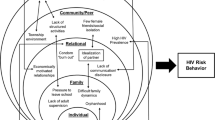Abstract
To develop an HIV prevention program for inner-city women at high risk for HIV heterosexual transmission, we conducted ethnographically informed, individual and focus-group interviews, with key participants, service providers, informal gatekeepers, and project staff—to elicit normative values, relationship contexts, and daily pressures, in participants' own terms. The high-risk woman is likely to be a Latina mother, in a long-term, if unstable relationship with a main male partner. Although she may not know it, he is likely to be involved in drug, especially heroin or cocaine, use. She is likely to have a history of alcohol and drug use. Although experience with HIV in people close to her is virtually universal, a sense of personal risk is rare. Experience with condoms or other safer sex, beyond experimentation, is also rare. Women are constrained by norms for male machismo; intense fears of relationship conflict, abandonment, or even violence; discomfort talking about sex; and strivings to have (more) children.
Similar content being viewed by others
REFERENCES
Centers for Disease Control and Prevention (1999). U.S. HIV and AIDS cases reported through June 1999. HIV/AIDS Surveillance Report, 11, 1-42.
Coreil, J. (1995). Group interview methods in community health research. Medical Anthropology, 16, 193-210.
Fullilove, M. T., Fullilove, R. E., Haynes, K., and Gross, S. (1990). Black women and AIDS prevention: A view towards understanding the gender rules. Journal of Sex Research, 27, 47-65.
Kane, J., and Mason, T. (1992). “IV drug users” and “sex partners”: The limits of epidemiological categories and the ethnography of risk. In G. Herdt and S. Lindenbaum (Eds.), The time of AIDS: Social analysis, theory and methods (pp. 199-222). Newbury Park, CA: Sage.
New York State Department of Health AIDS Institute (1995). The Community Need Index Report Series: Community Need Index for the NYC HSA Region. Albany: New York State Department of Health.
Patton, M. Q. (1990). Humanistic psychology and humanistic research. Special issue: Human inquiry & the person-centered approach. Person-Centered Review, 5, 191-202.
Strauss, A., and Corbin, J. M. (1990). Basics of qualitative research: Grounded theory procedures and techniques. Newbury Park, CA: Sage.
Tashima, N., Crain, C., O'Reilly, K. R., and Sterk-Elifson, C. (1996). The community identification process (CID): A discovery model. Qualitative Health Research, 6, 23-48.
Author information
Authors and Affiliations
Rights and permissions
About this article
Cite this article
Tross, S. Women at Heterosexual Risk for HIV in Inner-City New York: Reaching the Hard to Reach. AIDS Behav 5, 131–139 (2001). https://doi.org/10.1023/A:1011326827541
Issue Date:
DOI: https://doi.org/10.1023/A:1011326827541




